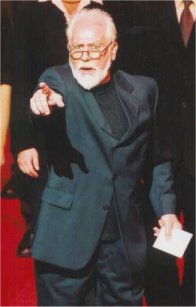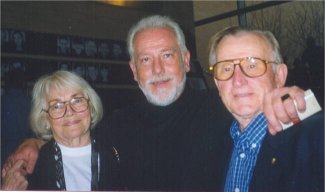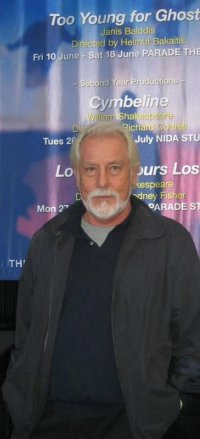
Helmut Bakaitis speaking at the
opening of the NIDA complex
in 2002
opening of the NIDA complex
in 2002

Helmut Bakaitis - Playwright,
Director, Actor
Director, Actor

Helmut Bakaitis next to a NIDA poster
However, Bakaitis’ full acting potential was revealed in Richard Foreman’s avant-garde play My Head was a Sledgehammer. It is a non-conventional play, without a delineated plot, without well-realised characters and without conventional drama possibilities, like scenes and acts. It is a play in which philosophical ideas of truth-relativity, reality-possibilities, tensions, sex, emotional and intellectual impotence are thrown from one actor to the other and ...yes, at the public at such a furious pace, that it is difficult to grasp their implications. It helped to have read the author’s intention in writing this play and how it should affect the audience in the program notes. Richard Foreman is quoted as saying:
"The spectator’s question should not be: ‘What does the play mean?’ The question should be. ‘In response to which of the world’s possibilities and tensions is the play created?’ That is it's meaning."

Helmut Bakaitis with parents 2002

It is stated in the program of the play Too Young for Ghosts by Janis Balodis that it is "... the first major Australian play to deal with post-war immigration. It parallels the story of the explorer Ludwig von Leichhardt with the arrival of a group of displaced people (DP’s) from war ravaged Europe." This statement should be expanded and it should be explained, that Too Young for Ghosts is the first part of Balodis’ epic trilogy The Ghost Story. The two other parts are: No Going Back and My Father’s Father.
The playwright, Janis Balodis, has written articles, essays, cinema scenarios, and twelve plays for the stage. He has received several awards for his literary output. Too Young for Ghosts was awarded the Victorian Premier’s Literary Award - Best Play in 1985. The play was staged in Melbourne, Sydney, and Brisbane and in 2005 by the NIDA Head of Directing, Helmut Bakaitis, with his Third Year Acting Students and the contribution of NIDA’s Design and Production Students in Sydney, 2005.
The director, Helmut Bakaitis, maintains that he found several reasons for staging a play about displaced persons. He felt an ethnic bond with the playwright. The author’s parents came from Latvia and his from Lithuania - two kindred small nations sharing their Indo-European descent and language in Northern Europe. Furthermore, he felt an emotional bond with the people who shared a common fate, by leaving their countries before the onslaught of the returning Soviet armies and becoming displaced persons in European camps. They had to start a new life elsewhere.
This second reason parallels Ludwig von Leichhardt’s exploration of Northern Queensland. There is also a third, perhaps not so obvious, underlying reason why these displaced persons and the Australian explorer Leichhardt, in particular, had a common trait. Leichhardt received financial support from William Nicholson to come to Australia and to explore hinterland routes. The displaced persons also received an assisted passage from the Australian government, for which they had to fulfil a two year work contract wherever they were sent. This parallelism was an interesting, but a difficult task, for the director to portray in the play. Too Young for Ghosts has two acts and fifteen scenes.

Helmut Bakaitis
It was, therefore, essential that costumes (several actors played double roles) and set changes were reduced to a minimum. This was very ingeniously achieved by using the same stage sets, props and lighting for all three locations and adding a slight change in actors’ outfits. The NIDA Design and Production students can be proud of their perceptive problem resolution.
The director aimed at identifying, juxtaposing and opposing the aims and goals of the explorer, the members of his expedition and the young DP’s. He accentuated their reaction to the unfamiliar landscape, people, customs and language.
The director wisely kept broken English and Leichhardt’s unmistakable German accent to a minimum - just enough to give the play an additional ethnic flavour. His choice of actors playing double roles - young Latvians and Leichardt, Australians and/or American GI’s - highlighted the common human moral traits, values and underscored the duality of human nature, its human and animal instincts. The director brought out positive sentiments and feelings, but didn’t shy away, albeit in a more subdued form, from portraying the darker side of human nature: black market dealings, selfishness, racism, rape and murder. Overshining these opposite poles was the common theme in the two parallel strands of the Latvian displaced persons and Leichhardt’s expedition. Both parties are exploring a new continent; both are hoping to find deserved rewards. This forward looking quality the director symbolically accentuated in Ilse’s late stages of pregnancy, as well as in her steadfast belief in a future life and Leichardt’s optimism and expectation of fame and handsome rewards in the future.
The Third Year NIDA Acting Students under the taut direction of Helmut Bakaitis played their roles and dual roles with competency. Their interplay was well coordinated. Some actors mastered the pauses in actions and in delivering their lines more confidently than others. However, this is a gradually acquired quality that comes with greater stage experience. On the whole, it was a well thought out, faithfully interpreted and well directed play about periods in Australian history that have rarely been explored.